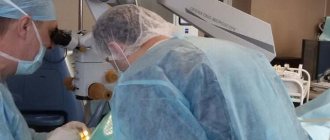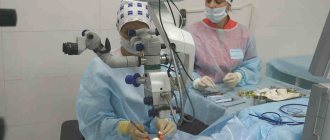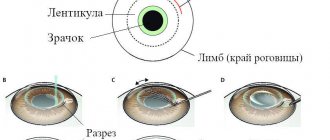The femtosecond laser beam is able to focus in the inner layers of the cornea without affecting the surface ones. At the focal point, a powerful energy effect (flash) is generated, which leads to the formation of an air bubble, which pushes the layers of the cornea apart at the molecular level. The laser produces several million such flashes.
Thus, the laser beam does not cut tissue like a knife, but delicately exfoliates it, practically without injuring it. Thanks to this, the rehabilitation period is shortened, and the patient almost immediately gains 100% vision.
In Europe, more than 80% of operations are performed using the Femto Lasik technique. Why?
- Fast healing and ideal flap stability.
- Everything is done by laser technology. The accuracy of the operation is so high that after a couple of months even an experienced ophthalmologist will not see a trace of the operation.
- Improving flap fixation, its rapid adaptation and fusion to the cornea.
- Ideal flap centering.
- 100% repeatability and guaranteed results.
Lasik technology:
All types of laser vision correction consist in creating a lens inside the cornea of the eye, which will actually allow you to see perfectly; the methods of vision correction differ only in how to get to the inner layer of the cornea in which the lens will be created.
The thin outer protective layer prevents you from actually getting to the inner layer of the cornea, and Lasik technology suggests cutting this top layer so that a “valve” appears. This flap is folded back, then a lens is created in the cornea with a laser and the flap is placed back.
A visual representation of Lasik technology is shown in the picture below:
Actually, all types of Lasik operations are carried out using this technology; the differences between different types of Lasik are only in how and what thickness the valve is made.
You can learn more about Lasik technology from the video:
Technique of the operation
What is Femto Lasik and how is the correction done? The modern method of laser vision correction Femtolasik is carried out in specialized ophthalmological clinics, which are equipped with the latest equipment and highly qualified specialists.
Before surgery, the patient is examined and undergoes the necessary list of tests. Concomitant pathologies must be taken into account. Then a direction is given to determine personal distortions of the cornea using an aberrometer. These studies are entered into a special computer program, where a model of the ocular system is created with visualization of all aberrations.
The data obtained is entered into a laser machine, where the result is scanned and an ideal diagram of the eye structure is created for a particular patient, taking into account individual characteristics.
Operational stages:
- The patient is placed on the couch, the head is fixed, an anesthetic substance is instilled into the eye and an eyelid speculum is placed, and the eye is centered.
- A femtosecond laser sends pulses into the cornea to an exact specified depth, after which so-called bubbles appear in the corneal layer, which tend to merge. This creates a peeling zone that can be easily pryed off and moved to the side.
- An excimer laser creates the required curvature of the cornea by evaporating it.
- The valve is returned to the place where the flap adheres by adhesion, due to the eye’s own collagen.
According to reviews of leading ophthalmological surgeons, the important point is the computerization of the process and the use of a laser to form the flap, so the human factor is reduced to zero.
Regular Lasik:
Actually, the very first version of this procedure is regular Lasik.
In this type of operation, a special blade, a microkeratome, is used to create the valve. This blade manually creates a fairly “thick” valve - approximately 130 microns (here everything depends on the quality of the microkeratome).
In general, this is the most standard type of Lasik surgery and is still used in “standard” cases, for people with completely healthy corneas.
Regular Lasik is the simplest and cheapest of all types of Lasik.
Stages of the procedure
Correction using a femtosecond laser takes place in several stages:
- Anesthetic drops are injected into the organ of vision. He completely loses sensitivity during the intervention; the patient does not experience any discomfort;
- The patient sits on the operating table near the laser unit. There is a small light above the operated area that blinks constantly. This helps to focus the patient's gaze on one point. A slight aversion of gaze will not affect the result of the operation in any way, but a strong aversion can nullify all the efforts of the surgeon. The movement of the organ of vision is corrected and controlled by special equipment;
- A vacuum tool is installed by eye, which in appearance resembles a cylinder. Using a laser, it is attached to the organ of vision;
- Then a flap is formed from the cornea, its parameters are calculated long before correction. The separation lasts a few seconds;
- The flap is moved to the side so that the laser beams can affect the deep layers of the cornea;
- Minor and short bursts of energy transform the damaged element. This helps normalize the process of focusing light fluxes;
- Upon completion of exposure to the cornea, the flap is returned to its original position. No stitches are required as the incisions close on their own almost instantly. During the correction process, the doctor actively uses the patient’s card, where all the nuances and parameters of the intervention were previously written down.
Return to contents
Femto Lasik:
The newest and most expensive version of Lasik at the moment.
With Femto-Lasik, the valve is created with a special Femtosecond laser. This laser allows you to create a valve of any thickness with minimal error; accordingly, with Femto Lasik, the thinnest possible valve is created, and due to the fact that the valve is created by a laser and not manually, it is more even and “grows in” better after it is put back.
Due to the fact that Femto Lasik allows you to create a very thin valve with maximum precision, this allows laser correction using this method even for people with very thin corneas who are not suitable for other methods. It is also believed that the recovery period after Femto Lasik is noticeably shorter than after regular Lasik.
You can find out more about how Femto Lasik works in the video:
Advantages of SMILE
- The absence of a flap and associated complications, primarily the likelihood of its displacement. In addition, it significantly reduces the risk of developing secondary keratoconus and dry eye syndrome (DES). If we talk about the occurrence of complications, then with FemtoLASIK they occur in 2% of cases, with ReLex SMILE 0.5-1% (with “traditional” LASIK - 6%).
- Possibility of performing the procedure on thin corneas.
- The complete absence of traces of the operation is important for people who are going to undergo a medical examination (pilots, law enforcement agencies - military, police, etc.). The fact that the patient has undergone laser vision correction can only be confirmed by optical coherence tomography of the cornea - OCT (a rather expensive and rare diagnostic method). The incision line along the edge of the flap after Femto-LASIK is visible during a standard slit-lamp examination (biomicroscopy). This may serve as a basis for an ophthalmologist to declare a person “unfit.”
- No significant restrictions from the second day (visiting the pool, gym, etc.). Important for people leading an active lifestyle.
SBK Lasik:
Another variation of Lasik for thin corneas.
With this method of laser correction, the surgeon tries to create the valve as thin as possible (within limits that are safe for the eye). The SBK attachment can be added to any other type of Lasik. That is, it could just be SBK-Lasik - this means that the valve will be created by a microkeratome, but as thin as possible.
Or maybe Femto SBK Lasik - this means that the valve will be created with a femto laser, but again as thin as possible.
Also, sometimes instead of the SBK prefix they use “Thin Flap”, which translates as “thin valve”, but the essence of the operation does not change. This method is needed for people with very thin corneas.
Preparing for surgery
Fourteen days before the procedure, you must stop wearing contact lenses. Lenses provoke the growth of blood vessels in the tissue of the cornea. This significantly complicates the operation.
| Two weeks before the correction, the doctor meets with the patient, conducts a thorough examination and assesses the condition of the operated area. He also checks with the patient for the presence of infectious or chronic pathologies. |
If factors are identified that may negatively affect the results of the intervention, the operation is postponed until they are eliminated. If it is impossible to get rid of them, then the correction is canceled altogether. The patient is offered an alternative treatment option.
On the day of the intervention, you should not use cosmetics, drink alcohol or take medications (especially those that thin the blood). You should also not wear perfume. It is recommended to wash your hair well, since water procedures are prohibited for five days after correction. There are no food restrictions, but just before going to the clinic you should limit yourself to a light snack.
It is not recommended to go to the hospital by car; use a taxi service or ask relatives for help. If you arrive at the clinic alone, without an accompanying person, you may not be allowed to undergo correction. This is due to the fact that after the intervention there are often some problems with vision clarity.
Super Lasik:
Super-Lasik is a Lasik operation tailored to an individual profile.
Here the issue is not in the method of creating the valve, but in the way the laser operates. With Super-Lasik, the laser not only creates a standard lens in your eye, but also takes into account your individual characteristics of the cornea. In this way, even people with complex astigmatism and other corneal problems can achieve ideal vision.
And again, the prefix “Super” can be added to any type of Lasik, that is, for example, it can be: Super-Lasik, Super-Femto Lasik, Super-SBK Lasik and others.
This “Super” type of operation, as I already said, is usually needed for those who have a non-standard cornea, for example, if you cannot choose glasses/lenses in which your vision is ideal, this may mean that you have some peculiarities of the cornea and you You will need Lasik according to your individual profile, that is, this very “Super” type of operation.
Positive and negative sides
The procedure has both advantages and disadvantages.
pros
Among the positive aspects, it is worth noting the following factors:
- The cells of the cornea are broken down using laser pulses. The impact lasts for a short time. Usually the procedure takes no more than ten minutes;
- Due to the short-term effect and small beam diameter (one micron), the laser does not affect nearby tissues. Therefore, the risk of damage to them is eliminated;
- Femto LASIK is allowed for patients with a thin cornea. Since the doctor can regulate the depth of exposure;
- The intervention does not cause pain and does not pose a threat to health. Since corneal excision is performed using a non-contact method, the risk of eye infection is eliminated;
- The rehabilitation period takes a little time. Complications may occur when mechanical instruments are used, in which case the edges of the flap are torn. Using a laser, it is possible to achieve a perfectly even cut;
- The technique allows you to get rid of many severe ophthalmological abnormalities.
Minuses
The disadvantages of Femto LASIK include:
- High cost of the operation;
- Laser beams do not completely separate corneal tissue. The shell and the formed flap remain connected to each other by microscopic bridges. When a piece is detached, they break and the result is minor irregularities;
- During the intervention, strong pressure is applied to the eye to achieve maximum immobility. A vacuum clamp is used for this purpose. The device exerts high negative pressure, which can result in retinal detachment and rupture. To eliminate the risk of such a complication, a thorough examination of the patient is performed before correction. If necessary, the retina is first strengthened.
Conclusion – Which type of Lasik should you choose?
Let's summarize: if you have a healthy cornea with normal thickness, then regular Lasik is enough for you.
If you have a thin cornea, then SBK-Lasik or Femto-Lasik will most likely suit you, and if you also have some non-standard features, then you will also need the “Super” version of the operation. As I already wrote above, simple Lasik is the cheapest. Femto Lasik is usually the most expensive type of surgery. You will also have to pay extra for the “Super” version of the operation. Therefore, many people have a question: do you need to overpay for all these “Femto”, “SBK” and “Super” versions of operations or can you do the cheapest regular version of Lasik?
As I said above, the cheapest regular version of Lasik is suitable only for those who have completely healthy eyes and no individual features. If, after an examination, the doctor tells you that it is better to undergo a more expensive operation, for example, Femto Lasik, then you should do just that, because... in your case it will be more reliable and safer, and the overpayment will be justified.
In general, only a doctor can tell you exactly what type of Lasik you need after a full examination.
Advantages of the method
The main and main advantages of the Femto LASIK vision correction technique:
- non-contact flap formation with micron precision;
- individual approach to each patient, taking into account corneal distortions;
- thin section (flap) of corneal tissue;
- the thickness of the valve is the same along its entire length;
- flap formation in just 6 seconds, this ensures a fast and effective recovery process after surgery;
- painless manipulation;
- taking into account the personal characteristics of the visual system.
LASIK surgery
The technique consists of the synthesized effect of a surgical instrument and laser on the cornea. The ophthalmologist cuts off a piece of corneal tissue and gently bends it back using a microkerat. Afterwards, the doctor burns out some areas of the incision with a laser, thus creating a new shape of the epithelial surface. The cornea of the eye is renewed and improved vision is formed.
Advantages
- The operation can be performed on both eyes;
- All procedures and the healing process take place within 24 hours;
- The surgeon uses local anesthesia in the form of eye drops that do not cause allergies or discomfort;
- The work takes place in the middle layer of the cornea, so the surface layer of the ocular epithelium is not damaged;
- No surgical sutures are required after the operation;
- The risk of any complications is minimal.
Femtolasik reviews after surgery
Most responses to the procedure are positive. Many patients note the effectiveness of the operation and the short recovery period. People are also attracted by the fact that during the intervention they do not experience pain or discomfort. And the result of the correction lasts for a long time.
The only drawback that patients note is the persistence of unpleasant symptoms (dryness, severe lacrimation) for one to two days. And, of course, they note the high cost of the procedure.











